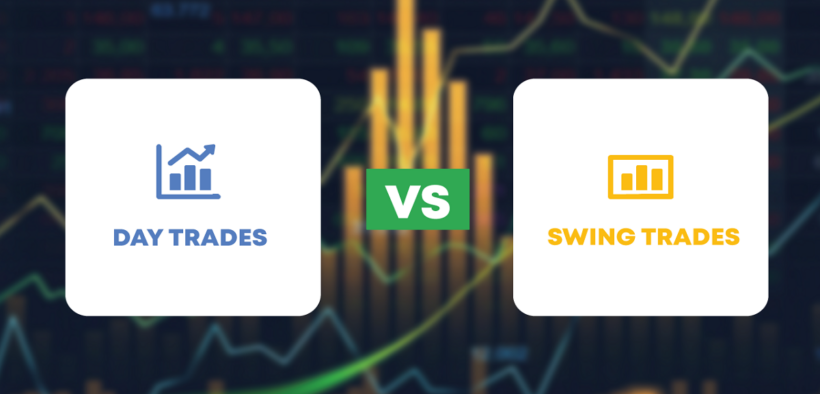Day Trading vs Swing Trading
Share

If you’ve been following the trading market then you must’ve been following the terms of day trading and swing trading. Though they act the same, there are some differences in why they are used differently. Both Trading styles can get you profits but they also depend on the available capital. In this article, we’ll be going over the differences between swing trading and day trading.
Difference Between Day Trading and Swing Trading
The Difference between day trading and swing trading can be segmented into different parts like Frequency. The number of transactions, Time required, and How to trade. We have broken down these segments in detail.
Trading Frequency
The day traders open and close positions multiple times in a day while the Swing traders take trades and hold them for days, weeks, and even months.
Number of Transactions
Swing trading is a fast-paced kind of trading in which trades are made over a period of days, weeks, or months. Swing trading accumulates earnings and losses at a slower rate than day trading. Certain swing trades might result in large wins or losses quickly.
Assume you’re a swing trader who puts 50% of your money at risk on each trade in the hopes of making 1% to 2% on winning deals, and you gain 1.5 % for winning trades while losing % on failing trades.
Each month, you make six trades and win half of them. As a result of the lower costs, you may make 3% on your account balance in a typical month. Over the course of a year, that works out to roughly 36%, which sounds excellent but is less than the possible earnings of a day trader.
Traders who seek rapid compounding of returns are drawn to day trading. The word “day trading” refers to the practice of traders buying and selling assets on the same day repeatedly.
The one 1% risk rule is widely used in the day trading world. You should never risk more than 1% of your investment on a single trade, according to this rule. Assume you’re a day trader who puts 0.5 % of your capital at risk with each trade.
You will lose 0.5% if you lose, but you will gain 1 percent if you win (a 2:1 reward-to-risk ratio). Assume you win 50% of your trades as well. On average, if you make six trades each day, you’ll add around 1.5 percent to your account balance each day, less trading fees. Even if you just made 1% a day, your account would increase by more than 200% in a year if you didn’t compound it.
Time Horizons
Swing trading is a trading method that involves making multiple trades over a period of days, weeks, or months. The idea is to profit in the short to medium term when market patterns shift.
Day trading involves making repeated trades over the course of one or two trading days in order to profit from daily price movements in as many small increments as possible.
Time Required
Day trading and swing trading both take time, but day trading takes far longer.
Traders who trade for at least two hours every day are known as day traders. When you factor in preparation time and chart/trading review, you’re looking at a minimum of three to four hours at the computer. If you trade for more than 2 or 3 hours a day, your time commitment increases significantly and trading becomes a full-time profession.
How You Trade
Swing traders can use their online brokerage accounts to create positions and trade because their time horizons are significantly longer. They aren’t in as big of a rush and don’t have to react to price changes in milliseconds.
To get started with swing trading, you’ll need to open and fund a brokerage account. You can start trading on their site once you’ve been funded.
To get the most out of your trading activity, you’ll need the most up-to-date software and technology if you’re day trading. Because prices can change before you decide to trade, automation is required to make trading lucrative.
To get started with trading like swing trading, you’ll need to have an account set up with a broker and have the system installed which allows you to see and access all the information you need.
Required Capital
The amount of money you’ll need to start swing or day trading is determined by what you’ll be trading rather than how you’ll trade.
In forex, there is no minimum existing day trading but your broker may need you to maintain a specific amount of capital in your account. Starting with at least $500, but $1,000 or more is preferable so you can participate in many deals.
Conclusion
One trading technique isn’t superior to another; it caters to diverse demands and preferences. Due to the higher frequency of trading, day trading provides a higher profit potential. Swing traders, on the other hand, still have a lot of profit potential. The amount of capital required varies depending on the market and trading style. Swing trading takes more time than day trading, but both require a lot of practice to become consistent. For thrill-seekers, day trading is the greatest alternative. Swing trading may be a preferable option for those looking for a less stressful and time-consuming solution.











